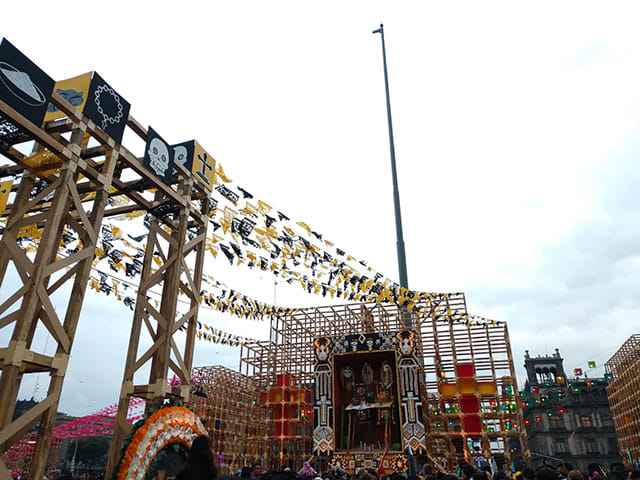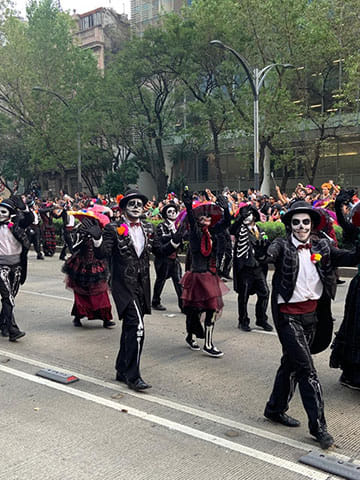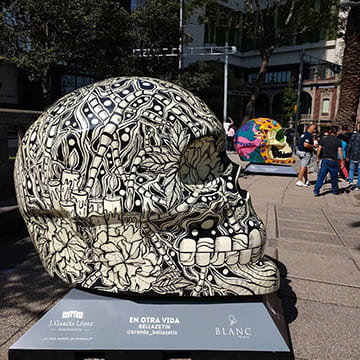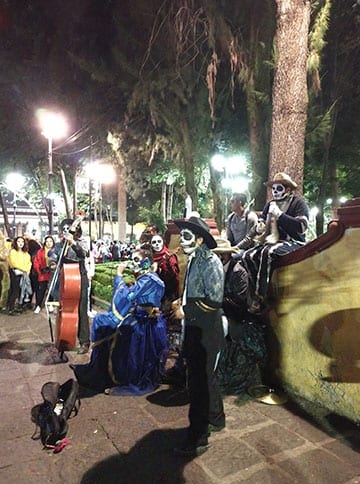The Day of the Dead (Día de Muertos in Spanish) is a public holiday in Mexico that is celebrated on November 1 and 2. They say that the souls of departed children return on the first, while the souls of the departed adults return on the second. There are some people that confuse it with Halloween, but it’s a completely different holiday—more like the Obon Festival in Japan. It’s a joyful and lively holiday that’s pure Mexico, with families and friends gathering together to reminisce about those they’ve lost, enjoy meals together, and so on. The movie Coco probably gave a lot of people a better idea of the purpose of the Day of the Dead and how people spend it. As it gets closer, the streets are transformed into a scene out of the movie, and most of the graves are adorned with colorful and festive decorations as well.

A café

A department store

A department store

Tissue box with a skeleton design
There has been a Mexican tradition of hanging the skeletons of ancestors nearby for 2,500 or 3,000 years. The Aztecs held a festival to honor Mictlantecihuatl (their Queen of the Underworld), and the celebration eventually developed into a celebration of La Calavera Catrina. When the Spanish invaded, it was further merged with the Catholic All Souls’ Day traditions, ultimately arriving at its current form.
There are a few things that you’ll always see on Día de Muertos.
The first is marigolds, which are known as the “flowers of the dead”. Marigolds, also a common flower in Japan, are important as a way to attract the souls of the departed. They’re used to decorate homes as well as restaurants and everywhere else. Even Paseo de la Reforma avenue in Mexico City is planted with marigolds, and their vibrant orange color is captivating.

The next unmistakable feature of the Day of the Dead are the oferendas, or altars, which are decorated with portraits of the deceased, pan de muerto, beverages, snacks, fruits, skeletons made of sugar or chocolate, candles, favorite objects of the departed, marigolds, and more. Families put out portraits of their ancestors, but restaurants and shops often decorate their oferendas with pictures of famous people who have passed on—and almost all of the decorations are vibrantly colored. It’s almost as if people are competing with one another over who can make the showiest display.

Oferenda at a restaurant

Oferenda at a supermarket

Mercado De Artesanías La Ciudadela

Giant oferenda at the Plaza del Zócalo
Mexican-style paper cutouts, called papel picado, are another essential feature. They’re used to decorate the entire town—not just the oferendas.

One of the signature foods you see on the Day of the Dead is pan de muerto. Every region prepares it differently, but the kind you see in Mexico City is considered the most classic. It’s a round, sweet bread that’s made to look like a skull, with a subtle orange aroma and dusted with sugar. You can get it anywhere during the holiday—from supermarkets to bakeries, cafés, even Starbucks. The basic flavor is the same no matter where you go, but every shop adds its own twist, so it’s fun to go out and find your favorite version.

Pan de muerto in a supermarket

Pan de muerto in Starbucks

Cream-filled pan de muerto
Southern Mexico is known for having the most spectacular Día de Muertos celebrations, the most famous being in Oaxaca and Isla de Janitzio. Thanks to Coco and the James Bond movies, however, the holiday has been gaining increasing attention from outside Mexico—so these days there are celebrations in nearly every part of the country. Apparently even Mexico City had few public events in the old days, though today there are parades that attract crowds of tourists each year.

Last year’s parades

Last year’s parades

Paseo de la Reforma
Even adults join in for the costumes and face painting during this time of year, and since it’s so close to Halloween, you see a lot of variation in the designs. Still, the most popular are skeleton-themed costumes like La Calavera Catrina, the Lady of the Dead. You can even buy face-painting stickers and other items in the supermarkets, or get your face painted in the city. Kids in big apartment complexes have Day of the Dead parties, with even kindergartens and schools joining in the celebrations.

Face painting

Face painting

People in costume
Although the Day of the Dead celebrations are very different from those held during the Obon Festival in Japan, people in every country feel the same about their loved ones who have passed on. We don’t have an oferenda set up in our house yet, but I’m thinking about putting out a picture of my grandparents next year and enjoying a little Mexico-style Obon celebration.






























































